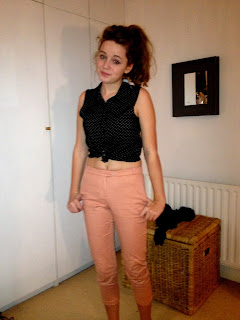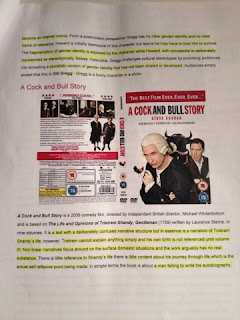Ellen Fraser
Hello choral drama people, (and please forward
this on to anyone you have on facebook but i haven't included / remembered or
any friends who are interested in drama or dance esp ) for my A2 media film we
have to make a music video, and for my piece i am including a montage of
sequences from different historical eras as my protagonist (main girl) travels
back through the decades to find herself (the idea probably makes no sense to
you right now but thats irrelevant for the moment). The reason i am explaining
all this is because tomorrow lunch we are filming the 1980's scene in the gym,
and we (me and my media group) already have quite a few people to come down and
take part but are desperate for others, we want people to dress in : leotards,
leg warmers, bright tights or leggings, sweat bands, or coloured hair pieces,
tight shorts, big denim jackets or cardy's / jackets etc basically 1980's http://www.google.co.uk/imgres?num=10&um=1&hl=en&client=safari&tbo=d&rls=en&authuser=0&biw=1360&bih=555&tbm=isch&tbnid=aZbdx3PZv5R5HM:&imgrefurl=http://www.simplyeighties.com/&docid=tHdVoEUhgvYnAM&imgurl=http://www.simplyeighties.com/resources/81_physical_98.jpg&w=322&h=478&ei=Txy1UJPXKIHO0QWl-YC4CA&zoom=1&iact=hc&vpx=337&vpy=4&dur=257&hovh=274&hovw=184&tx=108&ty=89&sig=115379148672381749777&sqi=2&page=1&tbnh=136&tbnw=91&start=0&ndsp=25&ved=1t:429,r:10,s:0,i:126 http://www.google.co.uk/imgres?start=25&num=10&um=1&hl=en&client=safari&tbo=d&rls=en&authuser=0&biw=1360&bih=555&tbm=isch&tbnid=GKb2JL2E06qBrM:&imgrefurl=http://mediarelations.illinoisstate.edu/report/1011/nov30/rec.asp&docid=MKacseNUA0tNCM&imgurl=http://mediarelations.illinoisstate.edu/images/600-00917063w.jpg&w=550&h=462&ei=Txy1UJPXKIHO0QWl-YC4CA&zoom=1&iact=hc&vpx=4&vpy=238&dur=420&hovh=206&hovw=245&tx=96&ty=110&sig=115379148672381749777&sqi=2&page=2&tbnh=141&tbnw=188&ndsp=34&ved=1t:429,r:25,s:0,i:19
if
anyone would be able to come to the school gym at 1:25 (lunch tomorrow) and be
in the video then my and my group would be SOOO grateful, all we want people to
do is literally dance along to a song & it would only be for a small while,
like i say if anyone would be able to come or get their friends to come i would
love you forever, thank you & don’t worry if no-one can make it.
20:12
Ela Pincham
: sounds really cool, I may be able
to come :) xxx
20:25
Sofia Victoria El-engibawy
: Will be
there.
20:25
Rosie
Barwick
I'll come :)xo
20:26
Thea
Goozée
okay;) : same i'll brign leggings and i will look for leg warmers
20:40
Rosie
Barr: I have some physics thingy but I'll defo come if I can get out of it
xxx
21:43 Hannah Brownie : sounds
awesome i will try and find stuff to wear...i might have rehersal not sure so
will have to double check but will try my best to be there xxxx
22:03 Tara Drummie : COUNT ME IN.
22:04 Rosie Barr : Yay Tara, we can skive physics together! ;)xx
22:07 Tara Drummie : yeaaa:') got it all sorted and in my bag:)))
22:16 Lotte Nash : I’ll be thereee :D
SHOOT
Our shoot went really well, everyone was so efficient, positive and proactive which made the filming so much easier to complete. Hair, make-up & mis en scene were a hug part of this scene - they helped to define the generic features of the era & create sterotyped iconography for our audience to relate to in order to catch on to the interextual link. We spent ages kitting everyone out with a huge variety of colourful tops, leotards, leg warmers, tights, jumpsuits, hoodies, jackets, trainers and so on. We did everyone's make and transformed the teen girls into brash, eccentric, 80's divas - hot pink lips, glittery blue eyes & hair in high pony tails, half pony tails, or curled. The location - a retro style gym, (along with the flash of colourful movement created and choreographed by myself and the other 'GEAR' girls before we started) helped to really bring the era to life. Everyone was so relaxed and co-operative and this was the atmosphere we really hoped to create, we wanted to ensure that our cast members felt at ease, as well as performing with energy & authenticity. We brought a fellow peer along to photograph the shooting, which enabled us to really get involved with our own work & stick meticulously to the story board with out additional tasks to complete. Thus moreover we managed to shoot each shot that we aimed to produce and now have a vast array of angle and different movement (camera) styles to sift through & choose our final footage, however in terms of some of the close up / extreme close up reaction shots & emotional expression we may be lacking in. Largely we concentrated on mass clips and making the extras feel as at home as possible & thus may need to consider later on when fully examining the footage if it's at a high enough standard for our liking.
SHOOT
Our shoot went really well, everyone was so efficient, positive and proactive which made the filming so much easier to complete. Hair, make-up & mis en scene were a hug part of this scene - they helped to define the generic features of the era & create sterotyped iconography for our audience to relate to in order to catch on to the interextual link. We spent ages kitting everyone out with a huge variety of colourful tops, leotards, leg warmers, tights, jumpsuits, hoodies, jackets, trainers and so on. We did everyone's make and transformed the teen girls into brash, eccentric, 80's divas - hot pink lips, glittery blue eyes & hair in high pony tails, half pony tails, or curled. The location - a retro style gym, (along with the flash of colourful movement created and choreographed by myself and the other 'GEAR' girls before we started) helped to really bring the era to life. Everyone was so relaxed and co-operative and this was the atmosphere we really hoped to create, we wanted to ensure that our cast members felt at ease, as well as performing with energy & authenticity. We brought a fellow peer along to photograph the shooting, which enabled us to really get involved with our own work & stick meticulously to the story board with out additional tasks to complete. Thus moreover we managed to shoot each shot that we aimed to produce and now have a vast array of angle and different movement (camera) styles to sift through & choose our final footage, however in terms of some of the close up / extreme close up reaction shots & emotional expression we may be lacking in. Largely we concentrated on mass clips and making the extras feel as at home as possible & thus may need to consider later on when fully examining the footage if it's at a high enough standard for our liking.
























































